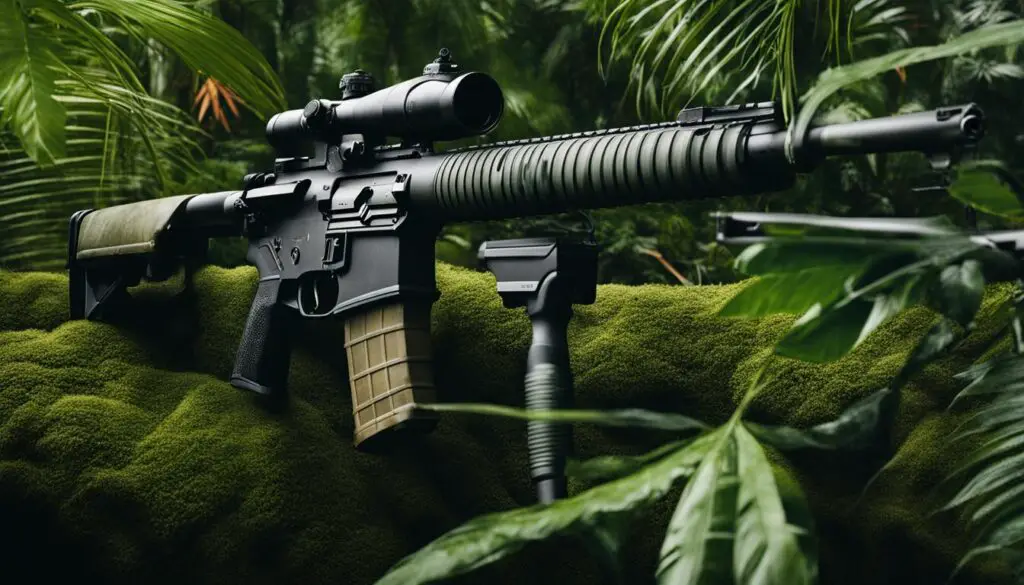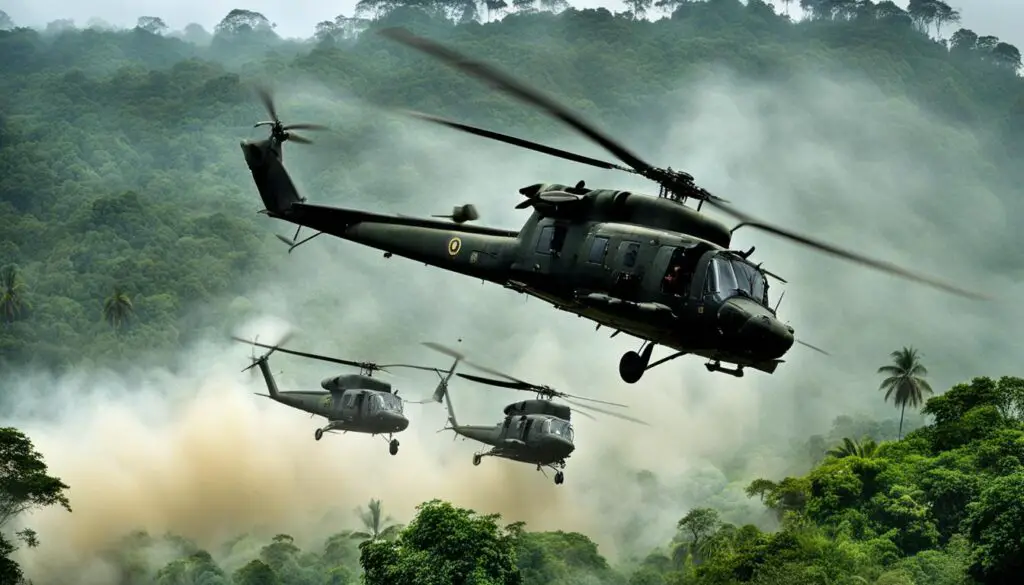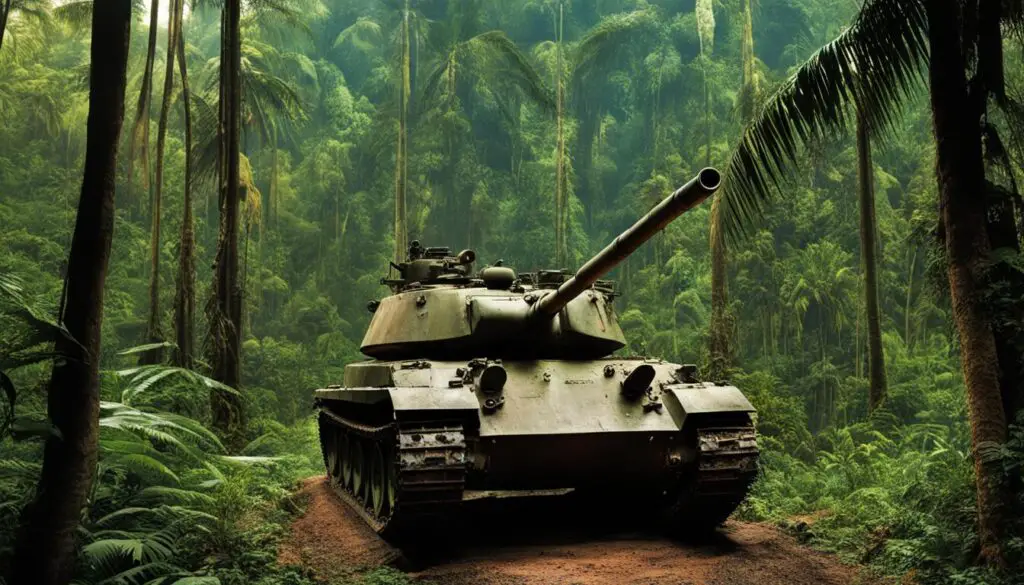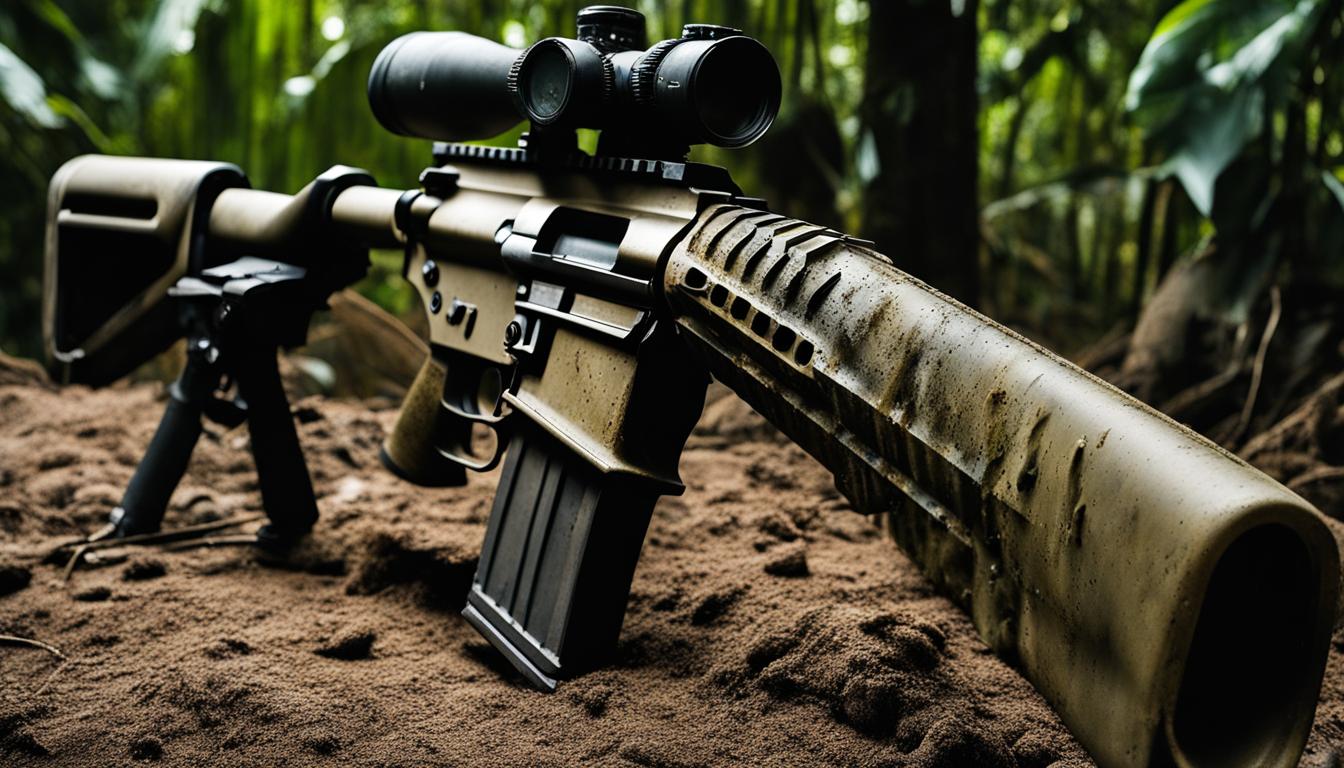The Vietnam War witnessed the use of a wide range of weapons that had a significant impact on the conflict. From rifles and explosives to helicopters and planes, these weapons played a crucial role in shaping military strategies and operations. In this article, we will delve into the different types of weapons used during the Vietnam War and explore their historical significance.
Key Takeaways:
- The Vietnam War saw the deployment of various weapons, including rifles, explosives, helicopters, and planes.
- Weapons such as the M-16 rifle and the Bell UH-1 Huey helicopter had a profound impact on the outcome of the war.
- The use of napalm raised controversy due to its destructive effects on both combatants and civilians.
- Vietnam War weapons left a lasting legacy on warfare, influencing military tactics and technological advancements.
- Exploring the history of Vietnam War weapons helps us understand their significance in shaping the outcome of conflicts.
The Key Weapons of the Vietnam War
The Vietnam War saw the deployment of several key weapons that were instrumental in the conflict. These included rifles, firearms, artillery, and explosives, each playing a crucial role in shaping the outcome of the war.
Rifles
The Vietnam War rifles were the primary weapon for infantry soldiers. One of the most iconic rifles of the war was the M-16, which became the standard issue weapon for U.S. forces. Its lightweight design and high rate of fire made it well-suited for jungle warfare. On the other side, the Viet Cong and North Vietnamese Army relied heavily on the AK-47, a robust and reliable assault rifle that became synonymous with their forces.
Firearms
Besides rifles, various firearms were used during the Vietnam War. Submachine guns such as the M3 “Grease Gun” and the Thompson M1A1 were commonly deployed by specialized units for close-quarter combat. Shotguns, such as the Remington 870, were used by soldiers for their versatility in jungle warfare, where engagements were often at a short range.
Artillery
Artillery played a crucial role in the Vietnam War, with both sides utilizing this weapon for long-range attacks. The U.S. employed a range of artillery pieces, including the M101 howitzer and the M107 self-propelled gun. These weapons provided the ability to deliver heavy firepower against enemy positions and played a significant role in offensive and defensive operations.
Explosives
Explosives such as grenades and mines were widely used during the Vietnam War. Soldiers carried hand grenades, like the M67 fragmentation grenade, for offensive and defensive purposes. Anti-personnel and anti-tank mines were employed to disrupt enemy movements and protect strategic locations. These explosives added another dimension to the tactics and strategies employed in the war.

| Weapon | Side |
|---|---|
| M-16 | United States |
| AK-47 | North Vietnam and Viet Cong |
| M3 “Grease Gun” | United States |
| Thompson M1A1 | United States |
| Remington 870 | United States |
| M101 howitzer | United States |
| M107 self-propelled gun | United States |
| M67 fragmentation grenade | Both sides |
| Anti-personnel mines | Both sides |
Air Power in the Vietnam War
The Vietnam War witnessed a significant use of air power, with helicopters and planes playing key roles in military operations. Helicopters, such as the iconic Bell UH-1 Huey, revolutionized warfare in Vietnam. These versatile aircraft were used for various purposes, including troop transport, medical evacuation, and close air support. With their ability to quickly and effectively navigate the challenging terrain, helicopters provided a tactical advantage to the forces on the ground.
Planes also played a vital role in the Vietnam War. The F-4 Phantom II and the A-4 Skyhawk were among the most widely used aircraft for bombing missions and air superiority. These planes carried out devastating air strikes, targeting enemy positions and infrastructure. The use of airplanes in the Vietnam War showcased the potential of aerial combat and changed the dynamics of warfare.

Overall, air power had a significant impact on the outcome of the Vietnam War. The deployment of helicopters and planes provided mobility, firepower, and support to the ground forces. The ability to transport troops quickly and efficiently, provide medical aid, and conduct airstrikes changed the way battles were fought. Air power in the Vietnam War highlighted the importance of controlling the skies and demonstrated the effectiveness of aerial tactics in modern warfare.
Armor in the Vietnam War
Armor played a limited role in the Vietnam War, primarily due to the challenging terrain and the guerilla warfare tactics employed by the Viet Cong. However, there were instances where armored vehicles were utilized for specific operations, providing a level of protection and firepower where feasible. One notable armored vehicle was the M48 Patton tank, which saw occasional deployment during the conflict.
Despite their limited use, tanks offered advantages in certain scenarios. They provided increased mobility and the ability to traverse rough terrain, giving American forces an advantage over the Viet Cong’s guerrilla fighters. Additionally, tanks offered substantial firepower, capable of neutralizing enemy positions and destroying fortifications.
However, the effectiveness of tanks in the Vietnam War was hampered by several factors. One issue was the thick vegetation that covered much of the Vietnamese landscape, making it difficult for tanks to maneuver effectively. Moreover, the nature of guerilla warfare meant that the Viet Cong often avoided direct confrontations with armored vehicles, opting instead for hit-and-run tactics and ambushes.
While tanks did not play a prominent role in the Vietnam War, their limited use demonstrated the importance of adaptability in warfare. The conflict highlighted the need for a comprehensive understanding of the terrain and the ability to employ diverse tactics to counteract unconventional warfare strategies.

The M48 Patton Tank Specifications
| Feature | Details |
|---|---|
| Weight | 45 tons |
| Length | 9.5 meters |
| Width | 3.7 meters |
| Height | 3.3 meters |
| Main Armament | 90mm gun |
| Secondary Armament | .50 caliber machine gun |
| Crew | 4 |
Table: Specifications of the M48 Patton Tank
Explosives and Grenades in the Vietnam War
The Vietnam War was characterized by intense combat and strategic warfare, and explosives and grenades played a vital role in shaping the outcome of battles. These powerful weapons were used by both sides to gain an advantage and inflict significant damage on the enemy.
Grenades were essential handheld explosives used by soldiers for offensive and defensive purposes. They were lightweight, portable, and highly effective in close-quarter combat. Soldiers would throw grenades into enemy positions or use them to counter enemy attacks. The fragmentation grenades, commonly known as “pineapple” grenades, were particularly popular due to their ability to produce deadly shrapnel upon explosion.
Additionally, the use of various types of explosives, such as Claymore mines and C-4 plastic explosives, provided soldiers with strategic advantages. Claymore mines were designed to be set up as booby traps, allowing soldiers to effectively ambush unsuspecting enemy forces. C-4 plastic explosives, on the other hand, were highly versatile and were used for various purposes like demolitions, destroying enemy structures, and disrupting enemy operations.
Types of Grenades:
| Grenade Type | Description |
|---|---|
| M26 Fragmentation Grenade | A standard-issue American grenade, known for its lethal fragmentation upon explosion. |
| RKG-3 Anti-Tank Grenade | A Soviet-made grenade specifically designed for anti-tank purposes; it could penetrate armored vehicles. |
| RGD-5 Hand Grenade | A Soviet-made defensive grenade, widely used by the Viet Cong and North Vietnamese Army. |
| M67 Fragmentation Grenade | An improved version of the M26 with greater effectiveness and a smaller lethal radius. |
The widespread use of explosives and grenades during the Vietnam War demonstrated their significant role in warfare. These weapons provided soldiers with the means to engage the enemy effectively, defend their positions, and disrupt enemy operations. The strategic use of explosives and grenades ultimately contributed to the overall success of military campaigns and altered the course of battles in Vietnam.

“Grenades were an essential part of our arsenal during the Vietnam War. We relied on them for close-quarters combat and to give us an edge on the battlefield. The power and versatility of these explosives cannot be understated.”
Overall, the use of explosives and grenades during the Vietnam War exemplified the innovative and adaptable nature of military tactics. Their impact on the outcome of battles and the ability to effectively engage the enemy in various situations solidified their importance as critical weapons of war.
Ammunition in the Vietnam War
The Vietnam War was characterized by intense combat operations that relied heavily on firepower. Ammunition played a critical role in sustaining the troops’ firepower and had a significant impact on the outcome of military engagements. From small-caliber rounds for rifles to large artillery shells, a wide range of ammunition was used during the war, each serving different purposes and roles on the battlefield.
One of the key types of ammunition used in the Vietnam War was armor-piercing rounds. These rounds were designed to penetrate armored vehicles, such as tanks and personnel carriers, providing a way to neutralize enemy armor and create a significant tactical advantage. The armor-piercing rounds were often used in conjunction with anti-tank weapons to maximize their effectiveness.
Another crucial type of ammunition used in Vietnam was explosive projectiles. These projectiles were used for various purposes, such as destroying enemy bunkers and fortifications, clearing vegetation, and creating obstacles for enemy forces. The explosive projectiles, when combined with accurate aiming and sufficient firepower, became powerful tools in disrupting enemy operations and gaining the upper hand in combat.
Table: Types of Ammunition Used in the Vietnam War
| Ammunition Type | Characteristics | Usage |
|---|---|---|
| Armor-piercing rounds | Penetrating power against armored vehicles | Neutralizing enemy armor |
| Explosive projectiles | Destructive power against fortifications and vegetation | Disrupting enemy operations and fortifications |
| Incendiary rounds | Starting fires and causing fire damage | Clearing vegetation and flushing out enemy positions |
Incendiary rounds were another significant type of ammunition used in Vietnam. These rounds were designed to start fires and cause fire damage, making them effective in clearing vegetation and flushing out enemy positions. The use of incendiary rounds was particularly prevalent in areas with dense foliage, where visibility and mobility were limited.
The variety of ammunition used in the Vietnam War showcased the importance of having a diverse range of firepower options to adapt to different combat scenarios. The innovation and development of these ammunition types played a crucial role in sustaining the momentum and effectiveness of military operations on the ground.
Napalm – A Controversial Weapon
Napalm, a highly flammable jelly-like substance, was extensively used during the Vietnam War. It was dropped from planes and ignited upon impact to create devastating fires. Napalm was used to destroy large areas of vegetation, clear landing zones, and flush out hidden enemy positions. However, its use sparked controversy due to the widespread destruction and its effects on both combatants and civilians.
The use of napalm in the Vietnam War had a profound impact on the conflict. Its ability to create intense and uncontrollable fires made it a powerful weapon, capable of causing significant damage to the enemy’s infrastructure and morale. However, the use of napalm also had devastating consequences for civilian populations and raised ethical concerns about the indiscriminate nature of its effects.
“Napalm is the most terrible pain you can ever imagine.” – Kim Phuc, a survivor of a napalm attack in Vietnam
The use of napalm in Vietnam resulted in numerous civilian casualties and inflicted unimaginable suffering on its victims. The infamous photograph of nine-year-old Kim Phuc running naked and severely burned after a napalm attack became an iconic symbol of the war’s brutality. The devastating impact of napalm on both combatants and innocent civilians raised questions about the morality of its use in modern warfare.
The Controversy Surrounding Napalm
The use of napalm in Vietnam ignited a global outcry and led to widespread protests against the war. The indiscriminate nature of its effects and its long-lasting environmental damage galvanized public opinion and fueled anti-war sentiments. The controversy surrounding napalm sparked a critical examination of the ethical boundaries of warfare and prompted calls for stricter regulations on the use of incendiary weapons.
| Impact of Napalm | Consequences |
|---|---|
| Devastated vegetation and infrastructure | Destroyed homes, schools, and hospitals |
| Caused severe burns and long-term health effects | Resulted in countless civilian casualties |
| Indiscriminate nature of its effects | Inflicted suffering on combatants and civilians alike |
The legacy of napalm in the Vietnam War serves as a stark reminder of the devastating consequences of warfare. Its use sparked important discussions around the ethics of targeting civilian populations, the long-term environmental impact of weapons, and the need for international regulations on incendiary substances. The controversy surrounding napalm continues to shape the way we perceive and engage in armed conflicts, highlighting the need for restraint and accountability in the use of destructive weapons.
The M-16 – A Game-Changing Rifle
The Vietnam War introduced several iconic weapons that played a significant role in shaping the conflict. Among these, the M-16 rifle emerged as a game-changer for the U.S. forces. Its lightweight design and improved firing capabilities offered soldiers a distinct advantage on the battlefield.
Although the M-16 initially faced reliability issues, it underwent crucial modifications and evolved into a highly effective weapon. The rifle featured a smaller caliber and utilized a high-velocity round, allowing for increased accuracy and range compared to its predecessor, the M14.
The M-16’s selective fire feature provided soldiers with the ability to switch between semi-automatic and fully automatic modes, enhancing their combat versatility. This weapon became a symbol of the U.S. military during the Vietnam War and was praised for its ease of handling and reliability once the initial design flaws were addressed.
| Key Features of the M-16 Rifle |
|---|
| Lightweight design |
| Improved firing capabilities |
| Selective fire mode |
| Smaller caliber and higher velocity |
The M-16 rifle played a significant role in changing the dynamics of warfare during the Vietnam War. Its lightweight nature and enhanced accuracy allowed soldiers to maneuver through the dense jungles of Vietnam with relative ease. The selective fire mode also provided them with the firepower needed to engage enemies effectively.
Overall, the M-16 rifle became a symbol of progress and innovation in military technology. Its impact on the outcome of the Vietnam War and subsequent conflicts cannot be overstated, as it paved the way for future advancements in individual firearms. The M-16’s legacy continues to influence weapon development and military strategies to this day.
Helicopters – The Backbone of Vietnam War Operations
During the Vietnam War, helicopters emerged as a crucial asset that revolutionized military operations. Their versatility, speed, and ability to operate in difficult terrains made them the backbone of combat operations. Helicopters were extensively used for troop insertion and extraction, medical evacuation, and resupply missions. Their presence on the battlefield fundamentally changed the way wars were fought and had a profound impact on the outcome of the Vietnam War.
One of the most iconic helicopters of the Vietnam War was the Bell UH-1 Huey. This versatile aircraft played a vital role in troop transport, providing mobility and flexibility to ground forces. It allowed troops to be swiftly deployed to different areas, providing tactical advantages and enabling rapid response to enemy movements. The Huey also served as a vital platform for medical evacuation, saving countless lives by quickly transporting wounded soldiers to field hospitals.
The use of helicopters also facilitated the establishment of Fire Support Bases (FSBs) in hostile territories. These bases acted as strategic outposts, providing a base of operations for ground troops and enabling them to project power into enemy-held areas. Helicopters were instrumental in delivering supplies, ammunition, and reinforcements to these FSBs, ensuring their effectiveness in sustaining military operations.
The Role of Helicopters in Combat Support
In addition to their role in combat operations, helicopters also played a critical role in combat support. They provided close air support to ground troops, suppressing enemy positions and offering rapid response to enemy attacks. Gunships equipped with machine guns, rockets, and grenade launchers carried out devastating attacks on enemy forces, bolstering the effectiveness of ground operations.
The widespread use of helicopters in Vietnam showcased their adaptability and effectiveness in asymmetric warfare. By granting troops increased mobility, firepower, and logistical support, helicopters played a pivotal role in countering the guerilla tactics employed by the Viet Cong. Their presence on the battlefield had a significant psychological impact, boosting the morale of ground forces and instilling fear in the enemy.
| Helicopter Model | Role | Significance |
|---|---|---|
| Bell UH-1 Huey | Troop transport, medical evacuation | Provided rapid mobility and lifesaving capabilities |
| Bell AH-1 Cobra | Attack helicopter | Engaged in close air support and suppressed enemy positions |
| Boeing CH-47 Chinook | Heavy lift and transport | Enabled the transportation of supplies and equipment to remote locations |
The use of helicopters in the Vietnam War paved the way for further developments in military aviation. Lessons learned from their employment shaped the design and capabilities of subsequent helicopter models, contributing to significant advancements in rotorcraft technologies. Today, helicopters continue to play a vital role in modern warfare, showcasing their enduring significance and legacy.
The Legacy of Vietnam War Weapons
The weapons used in the Vietnam War left a lasting legacy on warfare. The tactical innovations and technological advancements that emerged from this conflict shaped military strategies and influenced future weapon development. The experiences of the Vietnam War prompted changes in military doctrine and showcased the importance of adaptable and effective weapons in modern warfare.
The Vietnam War witnessed the introduction of several groundbreaking weapons that revolutionized military operations. One such weapon was the M-16 assault rifle, which became the standard issue firearm for U.S. forces. The M-16 replaced the M14 and offered soldiers a lighter and more reliable weapon. Although it faced initial reliability issues, the M-16 evolved over time and proved to be highly effective in the challenging terrain of Vietnam.
Another significant development was the extensive use of helicopters in combat. Helicopters such as the iconic Bell UH-1 Huey played a vital role in troop transport, medical evacuation, and close air support. These versatile aircraft provided the military with unprecedented mobility and the ability to access areas that were previously inaccessible by conventional means.
The legacy of Vietnam War weapons also extends to the controversial use of napalm. This highly flammable gelatinous substance was dropped from planes and ignited upon impact, resulting in devastating fires. While its use led to significant destruction and casualties, napalm highlighted the ethical considerations and consequences of employing certain weapons in warfare.
The Impact of Vietnam War Weapons
“The weapons used in the Vietnam War had a profound impact on military tactics and future weapon development. From the innovative use of helicopters to the introduction of advanced rifles, the war pushed the boundaries of conventional warfare and paved the way for modern combat strategies.” – Military Historian
The legacy of Vietnam War weapons can still be seen in contemporary military operations. The tactical lessons learned from this conflict continue to shape military doctrines around the world. The Vietnam War serves as a reminder of the importance of adaptable and effective weaponry in modern warfare, emphasizing the need for continuous innovation and improvement.
| Weapon | Description | Significance |
|---|---|---|
| M-16 Assault Rifle | The standard issue firearm for U.S. forces, known for its lightweight design and reliability. | Revolutionized infantry combat with its increased accuracy and firepower. |
| Bell UH-1 Huey | A versatile helicopter used for various purposes, including troop transport and close air support. | Transformed military operations by providing rapid mobility and access to difficult terrain. |
| Napalm | A highly flammable gelatinous substance used to create devastating fires. | Highlighted the ethical considerations and consequences of certain weapons in warfare. |
The Vietnam War was a catalyst for significant advancements in weaponry and military tactics. The lessons learned from this conflict continue to shape the way wars are fought today. As technology continues to evolve, the legacy of Vietnam War weapons serves as a reminder of the ongoing need for innovation and adaptation in modern warfare.
Conclusion
The weapons used in the Vietnam War played a crucial role in shaping the outcome of the conflict. From rifles and explosives to helicopters and planes, each weapon had its own significance and impact. The legacy of these weapons continues to influence military tactics and technological advancements today. By exploring the history of Vietnam War weapons, we gain a deeper understanding of the complexities of war and the role that weaponry plays in shaping its outcome.
FAQ
What were the key weapons used during the Vietnam War?
The key weapons used during the Vietnam War included rifles such as the M-16, firearms like the AK-47, artillery pieces, explosives such as grenades and mines, helicopters like the Bell UH-1 Huey, planes such as the F-4 Phantom II and A-4 Skyhawk, and tanks like the M48 Patton.
How did helicopters revolutionize warfare in Vietnam?
Helicopters revolutionized warfare in Vietnam by providing rapid mobility for troop transport, medical evacuation, and resupply missions. They allowed troops to access areas that were not easily accessible by ground, fundamentally changing the way wars were fought.
What role did explosives and grenades play in the Vietnam War?
Explosives and grenades played a vital role in Vietnam War combat. Grenades were used for offensive and defensive purposes, while explosives like C-4 and claymore mines were strategically employed for demolition and as booby traps to disrupt enemy forces.
What types of ammunition were used during the Vietnam War?
A wide variety of ammunition was used during the Vietnam War, including small-caliber rounds for rifles, large artillery shells, armor-piercing rounds, explosive projectiles, and incendiary rounds. Adequate ammunition supply was crucial for sustaining firepower in military operations.
How was napalm used during the Vietnam War?
Napalm, a highly flammable substance, was extensively used during the Vietnam War. It was dropped from planes and ignited upon impact to create devastating fires. Napalm was employed to destroy vegetation, clear landing zones, and flush out hidden enemy positions, but its use sparked controversy due to its widespread destruction and effects on combatants and civilians.
What was the significance of the M-16 rifle in the Vietnam War?
The M-16 rifle became the standard issue weapon for U.S. forces during the Vietnam War, replacing the M14. Despite initial reliability issues, the M-16 evolved into a highly effective weapon that played a significant role in the war.
How did the weapons used in the Vietnam War leave a lasting legacy on warfare?
The weapons used in the Vietnam War led to tactical innovations and technological advancements that shaped military strategies and influenced future weapon development. The experiences of the war prompted changes in military doctrine, emphasizing the importance of adaptable and effective weapons in modern warfare.
Source Links
- https://www.vietnamstay.com/blog/Diving-Into-The-Rich-History-Of-The-Cu-Chi-Tunnels
- https://www.teacherspayteachers.com/Product/US-History-Vietnam-Weapons-of-War-Project-7394038
- https://www.pbs.org/wgbh/amex/vietnam/

